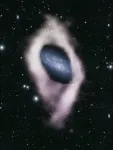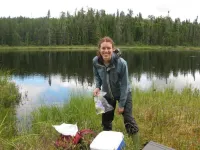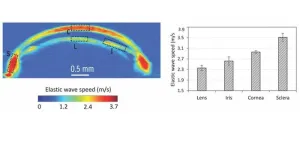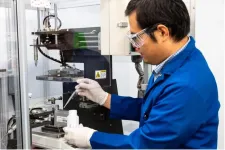(Press-News.org) KINGSTON, September 13, 2023 – A group of international astronomers, including researchers from Queen’s University, has identified two potential polar ring galaxies, according to results published today in the Monthly Notices of the Royal Astronomical Society.
Queen’s researchers Nathan Deg and Kristine Spekkens (Physics, Engineering Physics & Astronomy) led the analysis of data obtained using a telescope owned and operated by CSIRO, Australia’s national science agency. Looking at sky maps of hydrogen gas in over 600 galaxies as part of CSIRO’s ASKAP radio telescope’s WALLABY survey, they identified two potential polar ring galaxies, a type of galaxy that exhibits a ring of stars and gas perpendicular to its main spiral disk.
Although this is not the first time that astronomers have observed polar ring galaxies, they are the first observed using the ASKAP telescope located at Inyarrimanha Ilgari Bundara, CSIRO’s Murchison radio astronomy observatory on Wajarri Yamaji Country in Western Australia.
These new detections in gas alone suggest polar ring galaxies might be more common than previously believed.
Understanding how galaxies evolve
Further investigation of polar ring structures can help us better understand how galaxies evolve. For example, one of the main hypotheses to explain the origin of polar rings is a merger where a larger galaxy ‘swallows’ a smaller one. If polar ring galaxies are more common than previously thought, this could mean that these mergers are more frequent.
In the future, polar ring galaxies can also be used to deepen our understanding of the universe, with potential applications in dark matter research. It is possible to use polar rings to probe the shape of dark matter of the host galaxy, which could lead to new clues about the mysterious properties of the elusive substance.
Visualizing polar ring galaxies
Jayanne English, a member of the WALLABY research team and also an expert in astronomy image-making at the University of Manitoba, developed the first images of these gaseous polar ring galaxies using a combination of optical and radio data from the different telescopes. First, optical and infrared data from the Subaru telescope in Hawaii provided the image for the spiral disk of the galaxy. Then, the gaseous ring was added based on data obtained from the WALLABY survey, an international project using CSIRO’s ASKAP radio telescope to detect atomic hydrogen emission from about half a million galaxies.
The creation of this and other astronomical images are all composite because they include information that our eyes can’t capture. In this particular case, the cold hydrogen gas component, invisible to the human eye, is seen in radio “light” using CSIRO’s ASKAP. The subtle colour gradient of this ring represents the orbital motions of the gas, with purple-ish tints at the bottom tracing gas that moves towards the viewer while the top portion moves away. The emission from the ring was separated from the radio emission emanating from the disk of the galaxy using virtual reality tools, in collaboration with Professor Tom Jarrett (University of Cape Town, South Africa).
Over 25 global collaborators from Canada, Australia, South Africa, Ecuador, Burkina Faso, Germany, China, and beyond worked together to analyze the data from the first public data release of the WALLABY survey, resulting in the newly published paper.
The next step for the team is to confirm the polar ring galaxies finding through additional observations using different telescopes, including the MeerKAT radio telescope in South Africa.
For more information on the discovery, access the journal article.
Images of the polar ring galaxies and additional assets can be found in our Media Kit.
Quotes
“Polar ring galaxies are some of the most spectacular looking galaxies in the Universe. These findings suggest that one to three per cent of nearby galaxies may have gaseous polar rings, which is much higher than suggested by optical telescopes.”
Dr. Nathan Deg, researcher, Department of Physics, Engineering Physics & and Astronomy, Queen’s University, Canada, and lead author on the study
“These results are a really nice illustration of the tremendous value of mapping the sky more deeply and more widely than has ever been done before. This is serendipity at its best: we found things we certainly didn’t expect to find.”
Dr. Kristine Spekkens, Professor (cross-appointed from Royal Military College), Department of Physics, Engineering Physics & and Astronomy, Queen’s University, Canada
"I’m excited to work with such a diverse and collaborative team. We were able to work with data that showed a fine grid of velocity channels, which are equivalent to the radio stations on your old-fashioned radio receiver. The richness of the velocity data meant I could assign multiple colours to this composite to subtly convey the motion happening within the polar ring. The dance and choreography of the gas are beautiful, and that motion of the gas gives us some clues as to how galaxies evolve over time."
Dr. Jayanne English, Department of Physics and Astronomy, University of Manitoba
"Our ASKAP radio telescope is delivering a flood of data and we are ready for it. Using ASKAP, full WALLABY will deliver more than 200,000 hydrogen-rich galaxies among them many unusual objects like polar rings, which can be used to probe the shape and distribution of the dark matter halos."
Dr. Bärbel Koribalski, Senior Principal Research Scientist, CSIRO
“These new ASKAP observations, which reveal astonishing ring-like structures around otherwise normal looking spiral galaxies, suggest that the accretion of gas through interactions with gas-rich companion galaxies is much more common than we previously believed. WALLABY will be an amazing resource to uncover many more of such systems in the future.”
Professor Lister Staveley-Smith, WALLABY Co-Principal Investigator and Interim Executive Director. ICRAR
"One of the most exciting outcomes of a large survey such as WALLABY, which will scan most of the Southern sky to carry out the largest census of neutral atomic hydrogen ever done, is discovering the unexpected -- these unusual galaxies with beautiful gas rings are perfect examples of this." Assistant Professor Barbara Catinella, WALLABY Co-Principal Investigator and co-author of this study. ICRAR, The University of Western Australia
For more information, please contact:
Julie Brown
Media Relations Manager
Queen’s University
brown.julie@queensu.ca
343-363-2763
Fiona Odlum
Media Relations Officer
University of Manitoba
fiona.odlum@umanitoba.ca
END
Discovery of two potential Polar Ring galaxies suggests these stunning rare clusters might be more common than previously believed.
Queen’s researchers lead the discovery of two potential polar ring galaxies.
2023-09-13
ELSE PRESS RELEASES FROM THIS DATE:
Freshwater connectivity can transport environmental DNA through the landscape
2023-09-13
A new paper published in the journal Proceedings of the Royal Society B used environmental DNA (eDNA) metabarcoding to analyze fish and zooplankton communities. The study found that the movement of water between freshwater bodies, or freshwater connectivity, can transport eDNA. This highlights the potential of eDNA to provide a comprehensive view of freshwater biodiversity.
Aquatic ecosystems are connected by waterways, which allow fish, plants, and other organisms to move from one place to another. This connectivity is important for the resilience of aquatic populations, but it can also make it difficult ...
Largest historic fire death toll belongs to aftermath of 1923 Japan Earthquake
2023-09-13
Fires that raged in the days following the 1 September 1923 magnitude 7.9 Kantō earthquake killed roughly 90% of the 105,000 people who perished in and around Tokyo, making it one of the deadliest natural disasters in history—comparable to the number of people killed in the World War II atomic bombing of Hiroshima.
The story of the conflagration, not well-known outside of Japan, holds important lessons for earthquake scientists, emergency response teams and city planners, according to a new paper published ...
Nature’s great survivors: Flowering plants survived the mass extinction that killed the dinosaurs
2023-09-13
A new study by researchers from the University of Bath (UK) and Universidad Nacional Autónoma de México (Mexico) shows that flowering plants escaped relatively unscathed from the mass extinction that killed the dinosaurs 66 million years ago. Whilst they suffered some species loss, the devastating event helped flowering plants become the dominant type of plant today.
There have been several mass extinctions in the Earth’s history, the most famous caused by an asteroid hit 66 million years ago, which has steered the course of life on Earth profoundly.
The ...
Death rates following first heart attack have gone down for those without diabetes or with type 2 diabetes, but not for type 1 diabetes
2023-09-13
*Note- this is an early release from the Annual Meeting of the European Association for the Study of Diabetes (EASD) meeting in Hamburg, October 2-6. Please credit the meeting if you use this story*
New research to be presented at this year’s Annual Meeting of the European Association for the Study of Diabetes (EASD) in Hamburg, Germany (2-6 October) shows that, following a heart attack, there have been falls in the death rates of both people without diabetes and those with type 2 diabetes, but not those with type 1 diabetes. The study is by Dr Linn ...
University of Alberta to offer pioneering AI education to all undergraduate students
2023-09-12
The University of Alberta (U of A), a globally recognized leader in Artificial Intelligence (AI) and Machine Learning, along with Amii (Alberta Machine Intelligence Institute), are breaking new ground with the launch of "Artificial Intelligence Everywhere," a new online introductory course accessible to all U of A undergraduates. The course is the cornerstone for an in-development AI certification, which will be one of the first in Canada.
The course equips students across all disciplines with essential AI literacy skills. With AI permeating sectors from health care to finance, this initiative bridges the AI skills ...
Making mammography inclusive for patients with disabilities
2023-09-12
Lene Andersen, MSW, has been living with rheumatoid arthritis and disability since childhood. Her personal experience with limited mobility and the challenges faced in accessing mammography screening in Toronto, Ontario, has fueled her determination to advocate for change. Her story is featured in an upcoming themed issue of the Journal of Medical Imaging and Radiation Sciences on the topic of specialized populations, published by Elsevier.
In this personal narrative, Lene, an advocate and accessibility consultant, teamed up with Natasha Batchelor, MHSc, MRT(R), a medical imaging technologist from the York region in Ontario with expertise in creating an accessible mammography ...
New imaging technique measures elasticity of multiple eye components simultaneously
2023-09-12
The eye is a highly complex organ, composed of intricate structures combining several types of specialized tissues. Under normal conditions, these structures work seamlessly together to provide clear images of the world around us as well as maintain intraocular pressure. However, when ocular diseases set in, the biomechanical properties of eye components change, disrupting their normal functioning. Most importantly, the alternations in biomechanical properties of the eye often lead to significant ocular diseases and vision loss. In order to study, diagnose, and monitor ocular diseases, it is, therefore, ...
Novel emerging nano-assisted anti-cancer strategies based on the STING pathway
2023-09-12
https://www.scienceopen.com/hosted-document?doi=10.15212/AMM-2023-0023
Announcing a new publication for Acta Materia Medica journal. Activation of simulator of interferon genes (STING), which induces the production of proinflammatory factors and immune effector cell activation, is considered a promising strategy for enhanced anti-cancer intervention. However, several obstacles prevent STING signaling in solid tumors, such as delivered molecules’ rapid degradation, restriction to tumor sites, insufficient intracellular concentrations, and low responsivity. ...
'Team Waponi' advances to finals of $10M XPRIZE Rainforest Competition with 'Limelight', earns $300K semi-finalist prize
2023-09-12
NJIT biology professor Eric Fortune and a team of scientists, known as “Team Waponi”, have reached the final stage of the five-year, $10M XPRIZE Rainforest Competition.
In June, Fortune and 13 other team members traveled to the rainforests of Singapore to compete in the semi-finals of the global competition, which challenged teams to develop and demonstrate new technologies for mapping the vast biodiversity of the world's tropical forests.
The team’s biodiversity sampling device, called “Limelight”, has captured exactly that so far — securing them a spot among six finalists to advance from the field of 13 teams, while earning ...
Charging ahead: New electrolyte goes extra mile for faster EV charging
2023-09-12
Oak Ridge National Laboratory researchers are taking fast charging for electric vehicles, or EVs, to new extremes.
A team of battery scientists recently developed a lithium-ion battery material that not only recharges 80% of its capacity in 10 minutes but keeps that ability for 1,500 charging cycles.
When a battery operates or recharges, ions move between electrodes through a medium called the electrolyte. ORNL’s Zhijia Du led a team who developed new formulations of lithium salts with carbonate solvents to form an electrolyte that maintains better ion flow over time and performs well when high current heats up the battery ...
LAST 30 PRESS RELEASES:
Rising temperatures reshape microbial carbon cycling during animal carcass decomposition in water
Achieving ultra-low-power explosive jumps via locust bio-hybrid muscle actuators
Plant-derived phenolic acids revive the power of tetracycline against drug-resistant bacteria
Cooperation: A costly affair in bacterial social behaviour?
Viruses in wastewater: Silent drivers of pollution removal and antibiotic resistance
Sub-iethal water disinfection may accelerate the spread of antibiotic resistance
Three in four new Australian moms struggle with body image
Post-stroke injection protects the brain in preclinical study
Cardiovascular risk score predicts multiple eye diseases
Health: estimated one in ten British adults used or interested in GLP-1 medications for weight loss
Exercise to treat depression yields similar results to therapy
Whooping cough vaccination for pregnant women strengthens babies’ immune system
Dramatic decline in new cases of orphanhood in Uganda driven by HIV treatment and prevention programs
Stopping weight loss drugs linked to weight regain and reversal of heart health markers
Higher intake of food preservatives linked to increased cancer risk
Mass General Brigham–developed cholera vaccine completes phase 1 trial
First experimental validation of a “150-year-old chemical common sense” direct visualization of the molecular structural changes in the ultrafast anthracene [4+4] photocycloaddition reaction
Lack of support for people on weight loss drugs leaves them vulnerable to nutritional deficiencies, say experts
Dogs’ dinners can have greater climate impact than owners’
Are you ready to swap salmon for sprats and sardines?
1.6 million UK adults used weight loss drugs in past year
American College of Cardiology comments on new dietary guidelines for Americans
American Society of Gene & Cell Therapy and Orphan Therapeutics Accelerator partner to advance and commercialize promising rare disease treatments
One in 14 patients having day case surgery have new or worse chronic pain 3 months after their operation
New study highlights link between eviction rates and gun violence
Heatwaves heat up soil but not toxin levels in rice, study finds
Digital modeling reveals where construction carbon emissions really come from
Turning farm waste into water filters
New study shows how the spleen helps the immune system accept a transplant
New Mayo Clinic study advances personalized prostate cancer education with an EHR-integrated AI agent
[Press-News.org] Discovery of two potential Polar Ring galaxies suggests these stunning rare clusters might be more common than previously believed.Queen’s researchers lead the discovery of two potential polar ring galaxies.







